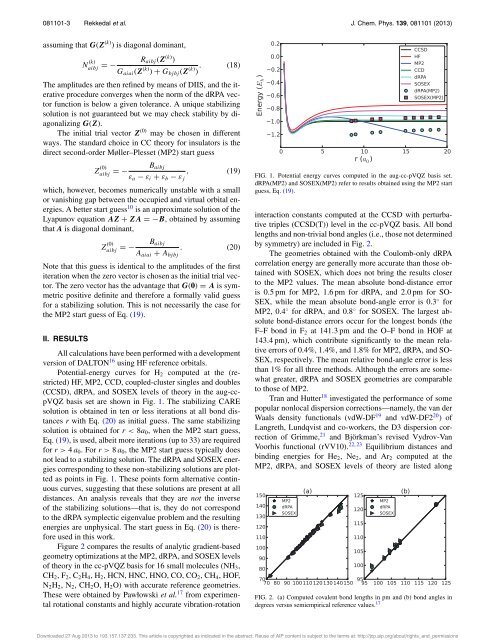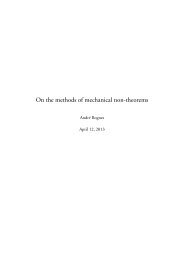Analytic gradients in the random-phase approximation
Analytic gradients in the random-phase approximation
Analytic gradients in the random-phase approximation
You also want an ePaper? Increase the reach of your titles
YUMPU automatically turns print PDFs into web optimized ePapers that Google loves.
081101-3 Rekkedal et al. J. Chem. Phys. 139, 081101(2013)<br />
assum<strong>in</strong>g that G(Z (k) )isdiagonaldom<strong>in</strong>ant,<br />
N (k)<br />
aibj =− R aibj (Z (k) )<br />
G aiai (Z (k) ) + G bj bj (Z (k) ) . (18)<br />
The amplitudes are <strong>the</strong>n ref<strong>in</strong>ed by means of DIIS, and <strong>the</strong> iterative<br />
procedure converges when <strong>the</strong> norm of <strong>the</strong> dRPA vector<br />
function is below a given tolerance. A unique stabiliz<strong>in</strong>g<br />
solution is not guaranteed but we may check stability by diagonaliz<strong>in</strong>g<br />
G(Z).<br />
The <strong>in</strong>itial trial vector Z (0) may be chosen <strong>in</strong> different<br />
ways. The standard choice <strong>in</strong> CC <strong>the</strong>ory for <strong>in</strong>sulators is <strong>the</strong><br />
direct second-order Møller–Plesset (MP2) start guess<br />
Z (0)<br />
aibj =−<br />
B aibj<br />
ε a − ε i + ε b − ε j<br />
, (19)<br />
which, however, becomes numerically unstable with a small<br />
or vanish<strong>in</strong>g gap between <strong>the</strong> occupied and virtual orbital energies.<br />
A better start guess 10 is an approximate solution of <strong>the</strong><br />
Lyapunov equation AZ + ZA=−B, obta<strong>in</strong>edbyassum<strong>in</strong>g<br />
that A is diagonal dom<strong>in</strong>ant,<br />
Z (0)<br />
aibj =−<br />
B aibj<br />
A aiai + A bj bj<br />
. (20)<br />
Note that this guess is identical to <strong>the</strong> amplitudes of <strong>the</strong> first<br />
iteration when <strong>the</strong> zero vector is chosen as <strong>the</strong> <strong>in</strong>itial trial vector.<br />
The zero vector has <strong>the</strong> advantage that G(0) = A is symmetric<br />
positive def<strong>in</strong>ite and <strong>the</strong>refore a formally valid guess<br />
for a stabiliz<strong>in</strong>g solution. This is not necessarily <strong>the</strong> case for<br />
<strong>the</strong> MP2 start guess of Eq. (19).<br />
II. RESULTS<br />
All calculations have been performed with a development<br />
version of DALTON 16 us<strong>in</strong>g HF reference orbitals.<br />
Potential-energy curves for H 2 computed at <strong>the</strong> (restricted)<br />
HF, MP2, CCD, coupled-cluster s<strong>in</strong>gles and doubles<br />
(CCSD), dRPA, and SOSEX levels of <strong>the</strong>ory <strong>in</strong> <strong>the</strong> aug-ccpVQZ<br />
basis set are shown <strong>in</strong> Fig. 1. Thestabiliz<strong>in</strong>gCARE<br />
solution is obta<strong>in</strong>ed <strong>in</strong> ten or less iterations at all bond distances<br />
r with Eq. (20) as <strong>in</strong>itial guess. The same stabiliz<strong>in</strong>g<br />
solution is obta<strong>in</strong>ed for r < 8a 0 ,when<strong>the</strong>MP2startguess,<br />
Eq. (19),isused,albeitmoreiterations(upto33)arerequired<br />
for r > 4 a 0 .Forr > 8 a 0 ,<strong>the</strong>MP2startguesstypicallydoes<br />
not lead to a stabiliz<strong>in</strong>g solution. The dRPA and SOSEX energies<br />
correspond<strong>in</strong>g to <strong>the</strong>se non-stabiliz<strong>in</strong>g solutions are plotted<br />
as po<strong>in</strong>ts <strong>in</strong> Fig. 1. Thesepo<strong>in</strong>tsformalternativecont<strong>in</strong>uous<br />
curves, suggest<strong>in</strong>g that <strong>the</strong>se solutions are present at all<br />
distances. An analysis reveals that <strong>the</strong>y are not <strong>the</strong> <strong>in</strong>verse<br />
of <strong>the</strong> stabiliz<strong>in</strong>g solutions—that is, <strong>the</strong>y do not correspond<br />
to <strong>the</strong> dRPA symplectic eigenvalue problem and <strong>the</strong> result<strong>in</strong>g<br />
energies are unphysical. The start guess <strong>in</strong> Eq. (20) is <strong>the</strong>refore<br />
used <strong>in</strong> this work.<br />
Figure 2 compares <strong>the</strong> results of analytic gradient-based<br />
geometry optimizations at <strong>the</strong> MP2, dRPA, and SOSEX levels<br />
of <strong>the</strong>ory <strong>in</strong> <strong>the</strong> cc-pVQZ basis for 16 small molecules (NH 3 ,<br />
CH 2 ,F 2 ,C 2 H 4 ,H 2 ,HCN,HNC,HNO,CO,CO 2 ,CH 4 ,HOF,<br />
N 2 H 2 ,N 2 ,CH 2 O, H 2 O) with accurate reference geometries.<br />
These were obta<strong>in</strong>ed by Pawłowski et al. 17 from experimental<br />
rotational constants and highly accurate vibration-rotation<br />
FIG. 1. Potential energy curves computed <strong>in</strong> <strong>the</strong> aug-cc-pVQZ basis set.<br />
dRPA(MP2) and SOSEX(MP2) refer to results obta<strong>in</strong>ed us<strong>in</strong>g <strong>the</strong> MP2 start<br />
guess, Eq. (19).<br />
<strong>in</strong>teraction constants computed at <strong>the</strong> CCSD with perturbative<br />
triples (CCSD(T)) level <strong>in</strong> <strong>the</strong> cc-pVQZ basis. All bond<br />
lengths and non-trivial bond angles (i.e., those not determ<strong>in</strong>ed<br />
by symmetry) are <strong>in</strong>cluded <strong>in</strong> Fig. 2.<br />
The geometries obta<strong>in</strong>ed with <strong>the</strong> Coulomb-only dRPA<br />
correlation energy are generally more accurate than those obta<strong>in</strong>ed<br />
with SOSEX, which does not br<strong>in</strong>g <strong>the</strong> results closer<br />
to <strong>the</strong> MP2 values. The mean absolute bond-distance error<br />
is 0.5pm for MP2, 1.6pm for dRPA, and 2.0pm for SO-<br />
SEX, while <strong>the</strong> mean absolute bond-angle error is 0.3 ◦ for<br />
MP2, 0.4 ◦ for dRPA, and 0.8 ◦ for SOSEX. The largest absolute<br />
bond-distance errors occur for <strong>the</strong> longest bonds (<strong>the</strong><br />
F–F bond <strong>in</strong> F 2 at 141.3pm and <strong>the</strong> O–F bond <strong>in</strong> HOF at<br />
143.4 pm), which contribute significantly to <strong>the</strong> mean relative<br />
errors of 0.4%, 1.4%, and 1.8% for MP2, dRPA, and SO-<br />
SEX, respectively. The mean relative bond-angle error is less<br />
than 1% for all three methods. Although <strong>the</strong> errors are somewhat<br />
greater, dRPA and SOSEX geometries are comparable<br />
to those of MP2.<br />
Tran and Hutter 18 <strong>in</strong>vestigated <strong>the</strong> performance of some<br />
popular nonlocal dispersion corrections—namely, <strong>the</strong> van der<br />
Waals density functionals (vdW-DF 19 and vdW-DF2 20 )of<br />
Langreth, Lundqvist and co-workers, <strong>the</strong> D3 dispersion correction<br />
of Grimme, 21 and Björkman’s revised Vydrov-Van<br />
Voorhis functional (rVV10). 22, 23 Equilibrium distances and<br />
b<strong>in</strong>d<strong>in</strong>g energies for He 2 , Ne 2 , and Ar 2 computed at <strong>the</strong><br />
MP2, dRPA, and SOSEX levels of <strong>the</strong>ory are listed along<br />
FIG. 2. (a) Computed covalent bond lengths <strong>in</strong> pm and (b) bond angles <strong>in</strong><br />
degrees versus semiempirical reference values. 17<br />
Downloaded 27 Aug 2013 to 193.157.137.233. This article is copyrighted as <strong>in</strong>dicated <strong>in</strong> <strong>the</strong> abstract. Reuse of AIP content is subject to <strong>the</strong> terms at: http://jcp.aip.org/about/rights_and_permissions
















